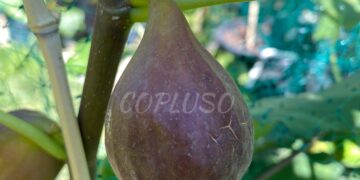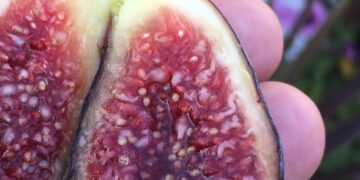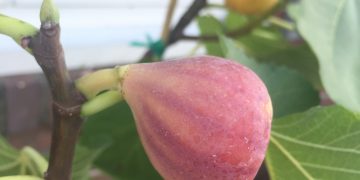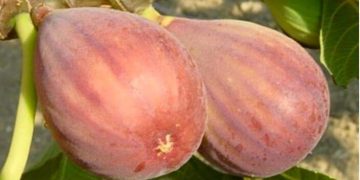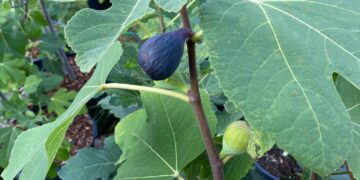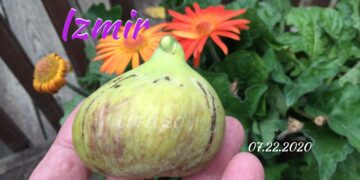Figs are a complicated fruit, in fact, they’re, not even fruits, they’re flowers actually inside out flowers and some of those flowers can only be pollinated by one particular kind of insect and that insect doesn’t make it out alive.
Like i said it’s complicated, but i’m going to clear everything up so, let’s get started, it breaks my heart that millions of americans have never tasted a fresh fig. I love the jammy texture of a perfectly ripe fig and compared to most other fruits, they’re an incredible source of fiber, calcium and potassium [, Music ].
No other fruit we eat is like a fig. A fig starts off as a clump of hundreds of teeny tiny flowers trapped inside a fleshy stem when those flowers are pollinated, they produce fruits, the real fruits see each one of these.
Tadpole-Like structures is an individual fruit with its own seed. Those seeds give dried figs. Their signature crunch, so if the flowers are inside the fig, how are they pollinated? Other plants need bees or wind to spread the pollen to the female flowers, but bees can’t possibly get inside this thing right, not to pollinate them.
They can’t lovely people meet fig farmer. Brent morgan, howdy so see this part here this is called an osteoall. You can call it the eye thanks what can possibly be so small that it can fit into a part.
That’S no bigger than a pinhole blastofag upsinis kazoon height, that’s the fig wasp right. So there’s one special kind of wasp that pollinates the fig and it’s tiny smaller than a nat there’s, actually a specialized wasp for each species of fig.
That’S amazing right, so fig wasps lay their eggs in male figs, which are inedible, but they have the male flowers. They’Re called capri figs and from the outside, it’s really hard to tell them. Apart from female figs, which are the ones we eat, the pregnant female wasp enters the capri fig through the eye.
She lays her eggs and the males hatch. First, they impregnate the female babies. Yep their own sisters and while they’re still in their eggs, the males then bore a hole outside of the fig for the females to escape when they hatch.
When the already pregnant females are born. They rub against the male flowers on the way out covering themselves in pollen. Now they go looking for a new capri fig to lay their own eggs in, but often they crawl into a female fig because they can’t even tell them, apart as the wasp enters the female fig, the pollen from the caprific rubs off her body and fertilizes.
The flowers which causes that fig to swell and ripen into the delicious fig we know and love now that’s great for us, but not so great for the wasp, because, unlike the capra fig, the female fig’s flowers cannot support her eggs.
Wait what happens to the mother wasp her wings get ripped off as she’s going inside the fig and she dies wait what there’s a dead wasp in my fig okay, we got ta get something straight, because i’ve seen a whole lot of hysteria across the internet about Whether we’re eating figs with wasps inside the chances of you eating a fig with a wasp in it if it was grown commercially in the u.
s, is virtually zero, almost all the fig varieties. We grow here ripen into fruit on their own black mission brown, turkey, kudota adriatic. They don’t need the wasp to bring in pollen because they’re self-fertile, it’s called parthenocarpi and you can learn all about it in our seedless fruit and vegetable.
Video i’ll put the link down below the only kind of fig here that does need. The wasp is the calamerna and it’s grown almost exclusively as a dried fig or for dried fig products like the filling in your fig newton.
So what about those calamernas? Are you crunching on dead, wasps inside your fig newtons? Well, the answer might surprise you, but first allow me to slip into something a little more comfortable, [, Music ].
So what about those Calamarinas? Are you crunching on dead wasps in your fig newtons? Well, not crunching. See figs contain a protein digesting enzyme called faison physin, essentially dissolves. The wasp, which remember, is so tiny.
It can pass through the eye of a needle. It basically becomes a pinch of liquid protein. Brent doesn’t need any wasps to grow figs in the orchard at hillgert farm. If this place looks familiar you’re right, it’s hg, haskell’s farm, where we brought you the incredible story of heirloom tomatoes and it’s where brent farms.
His 300 fig trees, all self-fertile using 100 organic practices. Brent himself is no ordinary fig farmer. For one thing, he only grows fresh figs. The vast majority of figs farmed in the u.s are for the dried market over 90 percent.
What is truly amazing about this orchard is that it is thriving in a very unlikely and difficult climate fig trees are native to the Mediterranean and the middle east, where it is hot and dry. This is Pennsylvania with humid, wet summers and bitter winters.
In fact, fig trees here regularly die back to the roots during the winter time. Yet brent is some kind of fig wizard, overcoming the elements and a vacuum of agricultural expertise. See the American fig industry is concentrated in California.
That’S why there’s been so little research invested into understanding how to grow figs outside of a warm dry climate, let alone fresh figs. Brent has had to achieve everything through trial and error.
A decade’s worth of pioneering experimentation, now fig trees can grow from seed, but it’s not guaranteed that they’ll have the same traits as the parents, so to get consistent varieties brent takes cuttings from his mature trees and establishes them in pots once brent transplants.
A young tree into the orchard he has to keep it protected from winter’s. Harsh temperatures he’s devised his own system of using string to anchor and fold each branch down to the ground. He puts bags of leaves over them as insulation and then covers it all with soft synthetic row cover by the way.
This is just a demo when brent does this for real in the fall, the branches have already lost their leaves now to grow great figs. In a place that gets a lot of summertime, rain brent has to do some super labor-intensive work in the springtime he has to prune each one of his 300 trees.
You want good light penetration into the canopy and also air circulation when things start to get too dense, it slows down ripening and you also start to get sort of more fungal problems with the leaves and the fruit i’ll go through and remove growths that don’t have Any fruit set, oh, i see, and i remove them completely just like this all the way at the base, but pruning comes with a unique risk check this out that milky white substance is latex.
It will actually burn your skin if exposed to sunlight. That latex is in the branches in the leaves, even in the stems of unripe figs. That’s why in California, harvesters have to wear gloves and long sleeves, because, unlike brent they’re, not really picking their figs at peak ripeness, if they did they’d be too soft to ship across the country? Instead, they have to pick them just as they start to ripen.
And that’s why there’s a threat of latex? So sometimes you know you really have to sort of get in and push things aside to find these figs. So there’s one eating leaves there’s one right there.
Okay, I’m going to try my hand here. Oh yeah, they come right off, it’s really easy. Okay and i don’t think i damaged the fruit yeah. Oh my god, look at that! Color [, Music ]! Oh my god, whoa now. The harvest for dried figs is something entirely different.
You’Re going to want to hear about that, especially if you’re worried about creepy crawlies in your figs but hold on, because brent’s got his own battles to fight with his fresh figs during harvest season.
Brent picks his figs every other day, the fruit at the bottom of the tree, ripens earliest, and the ripening continues up each branch. If he neglects to harvest the figs would become so soft and sugary that they’re essentially neon signs attracting all kinds of bugs.
Once you have over ripe figs in your orchard, you’re going to start to get ants, yellow jackets, honeybees fruit flies, can reproduce on. You know, fallen spoiled fruit, here at hillgart farm when harvest begins in September.
The figs that are picked are lusciously soft. Some have shallow cracks running down their lengths, which isn’t a defect by the way, with some varieties. It’s a sign, they’ve hit their absolute peak ripeness.
You won’t see that on grocery store figs. Very often, if you do that, you know that’s a good sign. You’re, still thinking about dead wasps. Aren’t you well. Let me give you something else to think about figs grown for dried fruit, which remember, is over 90 of the figs grown in this country.













